Thanks for joining me in No. 5 in a series of celebrating women harp guitarists! We last visited Central Europe for thirty incredible images, and now return to the States, circa 18950-1920.
After focusing on Gibson, Dyer and Knutsen instruments, I’ll now finish up with the many other American brands along with a couple “one-offs.” Some of these instruments were common, some exceedingly obscure – such as the Truax played by Estella McCutcheon seen in my first post. Similarly, the women below range from completely anonymous to forgotten entertainers on America’s performer circuits.
Let’s start with what we know of the latter…

This is Mrs. Potter – or to list her full given name, “Mrs. James E. Potter.” Yes, even though an equal with her husband in their c.1920 Lyceum circuit act, that’s all she could hope for. To be fair, in their own advertising circular, they were simply “The Potters.” She was said to be a gifted soprano, guitarist, and especially, “reader” – the term used for light dramatic staged vignettes. Her husband similarly did recitations and piano accompaniment; he’d also quickly don new costumes and wigs, as in the above image. I found one review in the Belvedere (Illinois) Daily Republic of Oct 1, 1920, describing a performance: “The Potters sang duets and solo numbers and each gave readings and accompanied one another on the piano. A feature was the playing of Home Sweet Home on a harp-guitar by Mrs. Potter while her husband recited a selection having this for the theme.”
Her instrument is the Bruno with twelve strings on the neck, introduced in 1901 and built up to the ‘twenties (mine is below).

Their handbill comes from the wonderful Special Collections Department of the University of Iowa Libraries and is used by permission.


Another rare handbill from U of Iowa depicts the lovely and sophisticated Hearons Sisters, who had a very successful Lyceum/Chautauqua touring act from 1897 to 1917. From left to right, they are Winifred (cornet and mandolin), Frances (violin and reader), Charlotte (clarinet and harp guitar), and Anna (piano and mandolin). They were a versatile instrumental act, with Anna doing the occasional recitation over the music just like the Potters did. From string quartet music with violin, mandolins, and harp guitar to the four of them performing on wine glasses, they must have been talented siblings, indeed!

Charlotte’s instrument is the well-known Lyon and Healy with “supplemental aluminum head piece” that held the sub-bass tuners (example shown, courtesy Retrofret). It was introduced c.1903 and was sold into the ‘teens.

The same L&H model is held by two young women in this undated Salvation Army Band photo.
You would think that there would be many more mandolin and guitar clubs with instruments other than Gibsons, those being so much more expensive, but that doesn’t appear to be the case. Here are rarer groups utilizing a variety of other brands of mandolins and guitars that happen to have female harp guitarists:
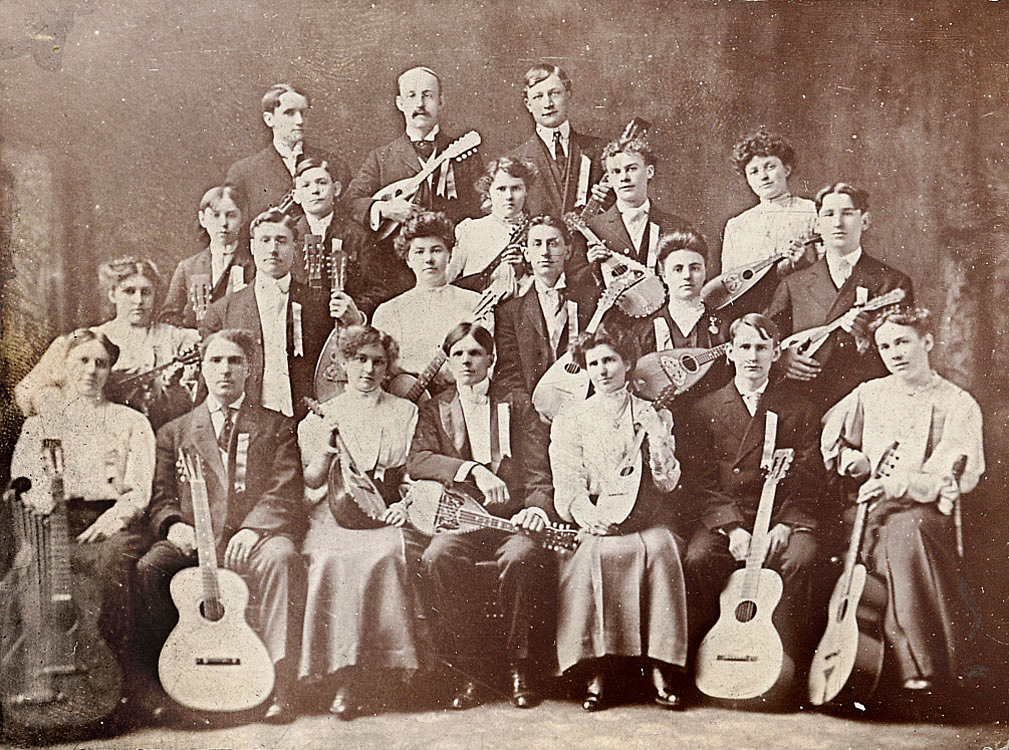
This anonymous turn-of-the-last-century club includes an example of America’s first production harp guitar, the late-1880s Harwood, as described in Floating Strings. Note its inlaid white logo block between the last frets.
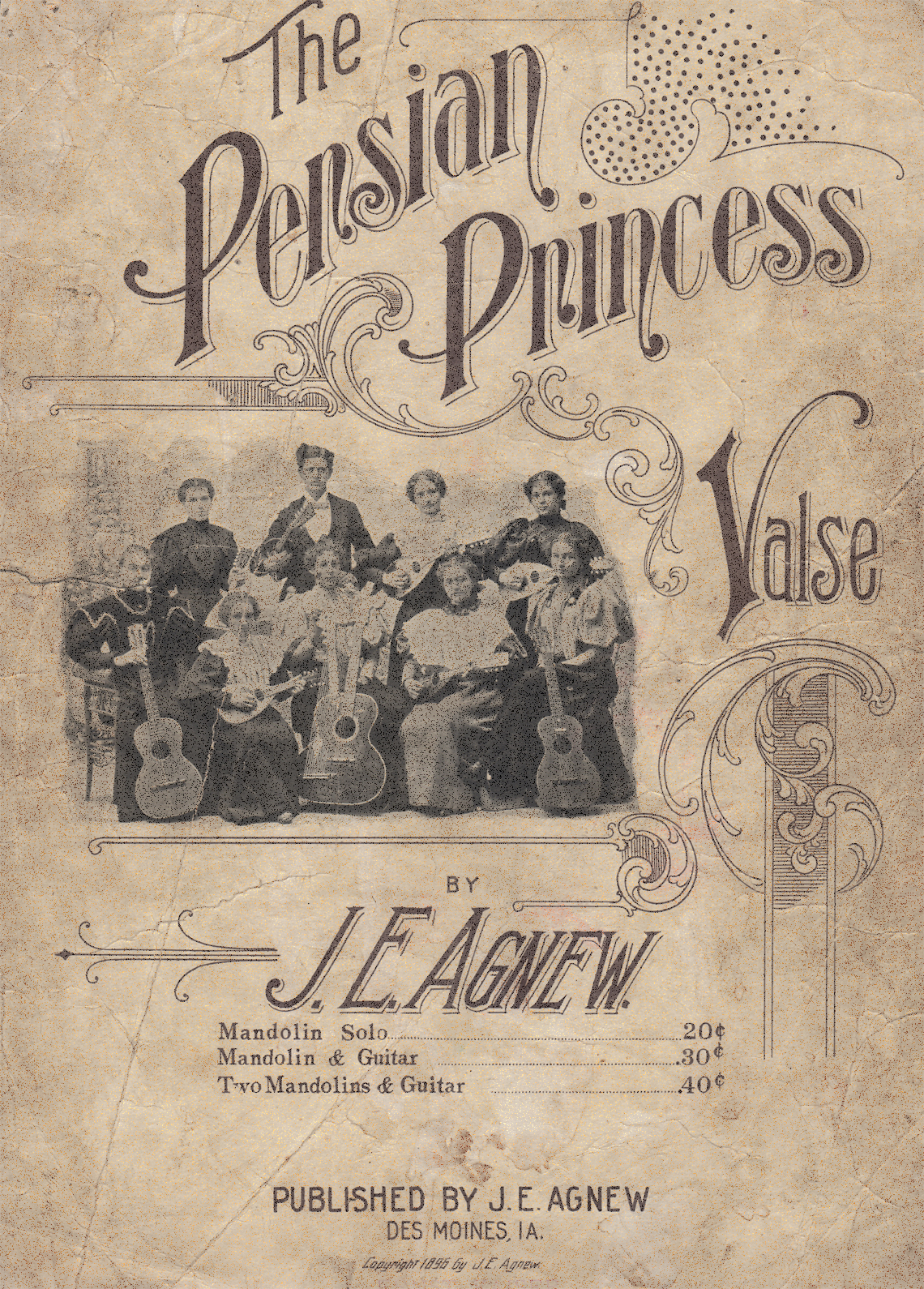
This 1896 “Persian Princess” sheet music (courtesy Barry Trott) features the Mystic Mandolin Club of Creston, Iowa. Their ensemble includes a Harwood 6-string on the right and an unusual one-of-a-kind harp guitar that I had never identified until just now! I’m certain that it is another unique mid-1890s instrument built by Tony Biehl of nearby Davenport, Iowa. Though its twelve sub-basses and unique offset neck support and extensive headstock are a far cry from his standard instrument, the plantilla (shape of the body) gives it away. Additionally, the shape of the head-connecting piece by the player’s hand emulates Biehl’s 6-bass instrument, seen here.
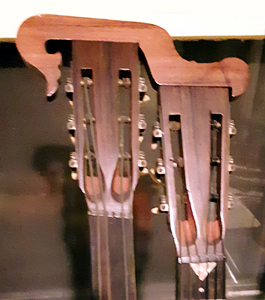


Another early ensemble that features a Minneapolis-made Dahlman harp guitar, patented in 1891. Its four sub-bass strings are plucked with the left thumb! (My example is shown below)
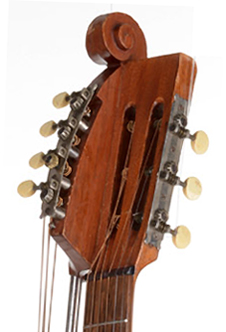

Back once more to Harwood, which I’ve written about at length. A teacher named Lester Payne was an agent/promoter for the brand, and the website includes many of his different ensembles through the years. (Again, you can tell the Harwood instruments from that white block inlay on the fretboard). In two of them, we see a woman with Lyon & Healy’s well-known Washburn “Terz Lyre Guitar” (mine is at below) …except it’s not! It’s an uncatalogued harp guitar version of the same instrument, with four floating basses.


 The above image with Lester Payne’s hand on the harp appeared on two sheet music titles, “Capriccio” from 1896 (courtesy of Jim Garber) and (undated, c.1903) “The Flower Song” (courtesy Barry Trott).
The above image with Lester Payne’s hand on the harp appeared on two sheet music titles, “Capriccio” from 1896 (courtesy of Jim Garber) and (undated, c.1903) “The Flower Song” (courtesy Barry Trott).
The woman and instrument appear again in a second image, featured on “The Suwanee River” sheet music from 1901 and this May/June 1900 Cadenza profile:

This stunning Lester Payne orchestra includes additional amazing instruments like Payne’s own ornately decorated guitar, two pedal harps (neither the same one from the previous photo), a rare Waldo mandocello and an incredible fretted upright six-string bass guitar!
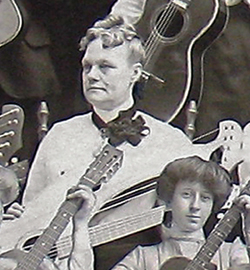
The same anonymous woman appeared (above) in Payne’s Orchestra with a Knutsen harp guitar in the famous 1902 Spokane concert that included Chris Knutsen himself. (I didn’t include her or the many other women in my previous Part 2, as we know that many of the women were simply posing with the near-dozen harp guitars Knutsen had brought along.)
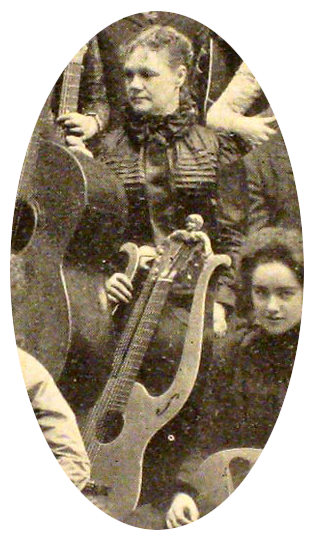
As the Washburn harp-lyre-guitar also appears in a c.1895 photo of a Lester Payne all-male group, it may be that he owned it himself. We can be certain that the woman was a guitarist and only seen with a harp guitar in all of her images, but we can only guess whether or not she played her sub-basses.


This combined Glee Club (nice to see the women outnumbering the men for once) features a beautiful harp guitar likely built by the same Chicago Larson brothers who built the hollow-arm Dyers.
It’s recognizable by its “Stauffer-style” bass headstock and oversize soundhole, which denotes the H. F. Meyer (a guitar teacher) or possibly MayFlower brand.

An anonymous young woman playing dress-up Hawaiian, with a common c.1920 harp guitar built by many firms, most commonly Wurlitzer (below). Its dark top and metal strap may or may not be original.

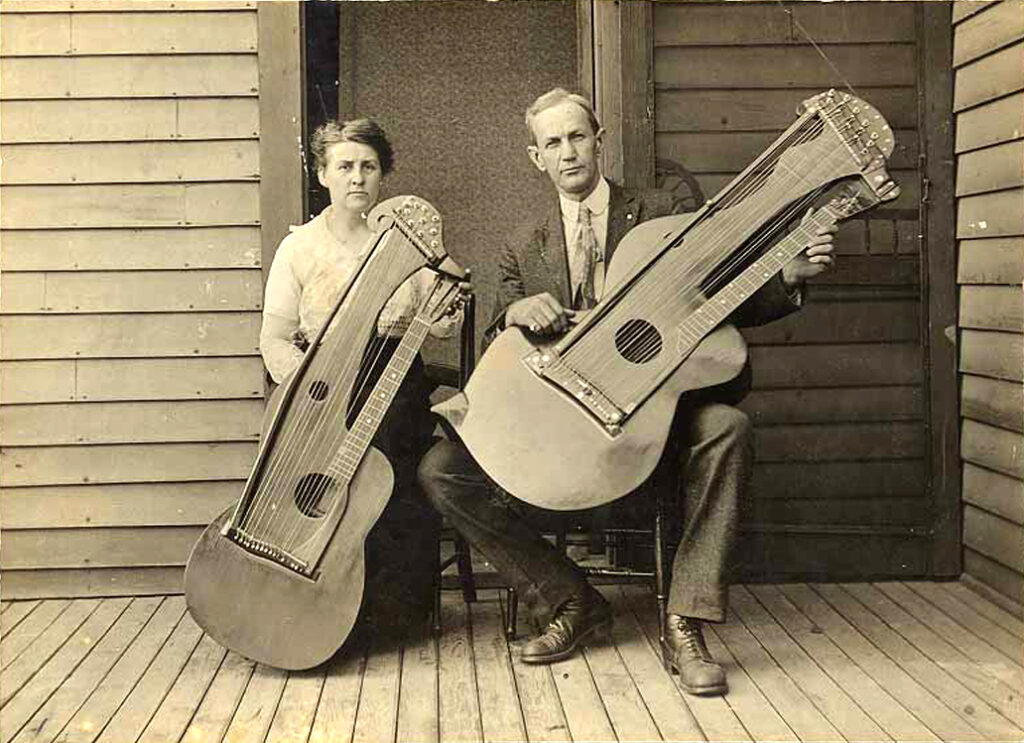
A treasure shared by Jeff Carr 20 years ago. The couple plays incredible homemade “harp-zither-guitars,” with the 11 to 14 floating strings set up in “chord groups” as in the common fretless zithers. I’m guessing early 1900s, as one seems based on a Knutsen, the other on a Gibson. With such amazing instruments, you’d think they be happier about it.


I’ve found nothing on the Florentine Troubadours of Portland, featured on this 1898 sheet music title (courtesy Barry Trott).
Their harp guitarist plays one of Joseph Bohmann’s many individualistic harp guitars. This one appears to have the giant 19” wide and two feet long “contrabass” body.
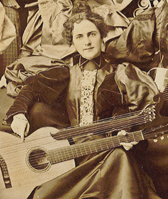
We have one last Bohmann harp guitar player, and I’ve been waiting since 2013 for my colleague to finish his research so we can properly present her. Finally, this series provided the incentive to complete the work.
Next: A Special Profile of an American Artist by Guest Author Bruce Hammond!






I think I commented on Facebook before, but worth saying here how my fascination for a 14-bass HG of this build form existing in the heyday persists. Thanks to Jeff for such a record setting photo and Gregg as master curator, knowing what he has and when to bring it to the audience’s attention again in his illustrating his current narratives. The beauty of the diversity of research of this blog draws attention to the similarity of instrumentation of the Hearons Sisters act in this article and that of the Invincible Four a few months ago, whilst the music they played, I propose, could have sounded rather different. The 1910s remain the most fascinating decade in American musical history for me for these sorts of reasons. Thanks
I love looking at all the faces of these ladies and knowing that quite a few may be small in stature, it is amazing to see the size of the harp-guitars in front of them. What an era! Again, thank you, Gregg for educating us all about these “splendid” musicians. (Sorry, I couldn’t resist as the music “critic” used is several times in one paragraph!) SMC